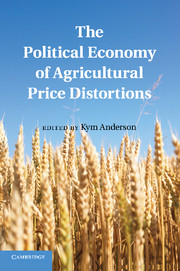Book contents
- Frontmatter
- Contents
- List of Figures
- List of Tables
- Contributors
- Foreword
- Preface
- Abbreviations and Acronyms
- PART ONE Introduction
- PART TWO CONCEPTUAL FRAMEWORKS AND HISTORICAL ORIGINS
- Part Three Political Econometrics: the Past Fifty Years
- Appendix: Coverage and Distribution of Assistance across Countries and Products, 1955–2007
- Index
- References
Appendix: Coverage and Distribution of Assistance across Countries and Products, 1955–2007
Published online by Cambridge University Press: 05 July 2011
- Frontmatter
- Contents
- List of Figures
- List of Tables
- Contributors
- Foreword
- Preface
- Abbreviations and Acronyms
- PART ONE Introduction
- PART TWO CONCEPTUAL FRAMEWORKS AND HISTORICAL ORIGINS
- Part Three Political Econometrics: the Past Fifty Years
- Appendix: Coverage and Distribution of Assistance across Countries and Products, 1955–2007
- Index
- References
Summary
The core global database that was developed as an integral part of the World Bank's research project on Distortions to Agricultural Incentives is publicly available at www.worldbank.org/agdistortions (Anderson and Valenzuela 2008). Case studies from which it is derived cover a total of seventy-five countries that together account for between 90 and 96 percent of the world's population, farmers, agricultural output, and total GDP. They also account for more than 85 percent of farm production and employment in each of Africa, Asia, Latin America, and the transition economies of Europe and Central Asia, as well as all OECD countries. The only countries not well represented in the sample are those in the Middle East and the many small ones that together account for less than 5 percent of the global economy.
Nominal rates of assistance and consumer tax equivalents (NRAs and CTEs) are estimated for more than seventy different products, with an average of eleven per country. In aggregate, the coverage represents around 70 percent of the gross value of agricultural production in the focus countries and just under two-thirds of global farm production valued at undistorted prices over the period covered. Not all countries had data for all of the 1955–2007 period, but the average number of years covered is forty-one per country. Estimates for the transition economies of Europe start in 1992 and for China and Vietnam in 1981 and 1986, respectively.
- Type
- Chapter
- Information
- The Political Economy of Agricultural Price Distortions , pp. 393 - 426Publisher: Cambridge University PressPrint publication year: 2010
References
- 2
- Cited by



